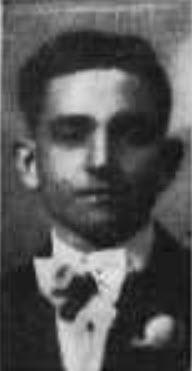-
Place of Birth
Columbus, Indiana, US
-
Place of Death
Indianapolis, Indiana, US
-
Burial Place
Crown Hill Cemetery, Indianapolis, Indiana, US
The Life and Loss of Grover Thomas Beyl (1891–1938)
Born under shifting stars and census contradictions, Grover Thomas Beyl entered the world on July 25, 1891—at least, according to his death certificate. Most other records mark his birth in 1892. Regardless of the exact year, his story would be anything but ordinary.
Roots in Columbus, Indiana

In the summer of 1900, young Grover was just a boy of eight or nine, living at 228 Jackson Street in Columbus, Bartholomew County, Indiana. The Beyl household was full to the brim: father Jacob, a French-born carpenter who immigrated in 1852; mother Margaret, Indiana-born but of proud German stock; and a band of siblings that included Jacob Jr., Mary, Edward, and Lillie. There was even a granddaughter in the house—little Helen M., born just a year before the turn of the century.

Their home echoed with a blend of languages, hammers, and chalkboard scratches—Jacob and Jacob Jr. building with wood, and the younger children dutifully attending school. It was the American dream, growing out of immigrant sweat and Midwestern soil.
Finding His Trade (and a Touch of Trouble)
By 1910, the Beyls had moved a few doors down to 542 Jackson Street. Jacob Sr. had laid down his tools and retired, while Margaret labored in a poultry house—listed quaintly as a cheeser. Grover, not yet 20, was a laborer in the furniture industry. Hard work was in the Beyl blood.

Indianapolis soon beckoned, and Grover followed its siren call of opportunity. In 1912, he worked as a machinist in the city and lived with his brother Edward. The neighborhood they called home is now a parking lot—history quite literally paved over.
Love, War, and New Beginnings
Grover’s brothers were Jacob W., age 33, and Edward, age 23, who worked as Laborers at a liquor factory. Grover was a Laborer in the furniture industry. Jacob Sr. and his parents were born in France; Margaret’s parents were born in Germany. Everybody else was born in Indiana.

In 1912, Grover lived at 916 Bates Street, Indianapolis, Indiana, according to U.S. records. City Directories, 1822-1995. Grover was a machinist at the time. He lived with his brother Edward, who was a Packer. That neighborhood has since been demolished, and a parking lot now occupies the site of the house.
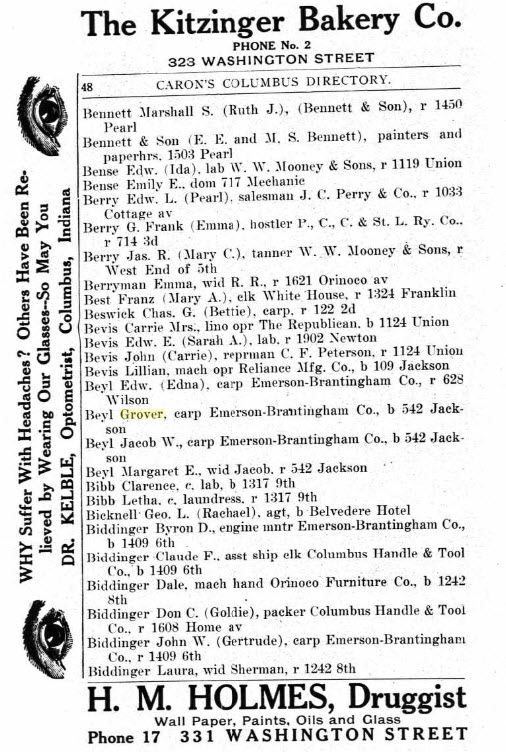
In 1915, Grover lived at 542 Jackson Street, Columbus, Indiana, according to U.S. records. City Directories, 1822-1995. Grover was a Carpenter at the time with Emerson-Brantingham Co., as were his brothers, Edward and Jacob W., and Grover was living with their mother, Margaret E., who was a widow by this point. That house, along with the rest of the neighborhood, has since been torn down to make way for a parking garage and city buildings.

In 1917, Grover lived at 602 Woodlawn Avenue in Indianapolis, according to U.S. records. City Directories, 1822-1995. Grover was a Packer at the time.
In 1917, Grover registered for the World War I draft. He was 24 years old, with gray eyes, brown hair, and a medium build. That same year, he married Katherine Marie Mayer on March 10th—a union that would mark the next chapter of his life. Together, they set up a home at 1417 E. Tabor Street.
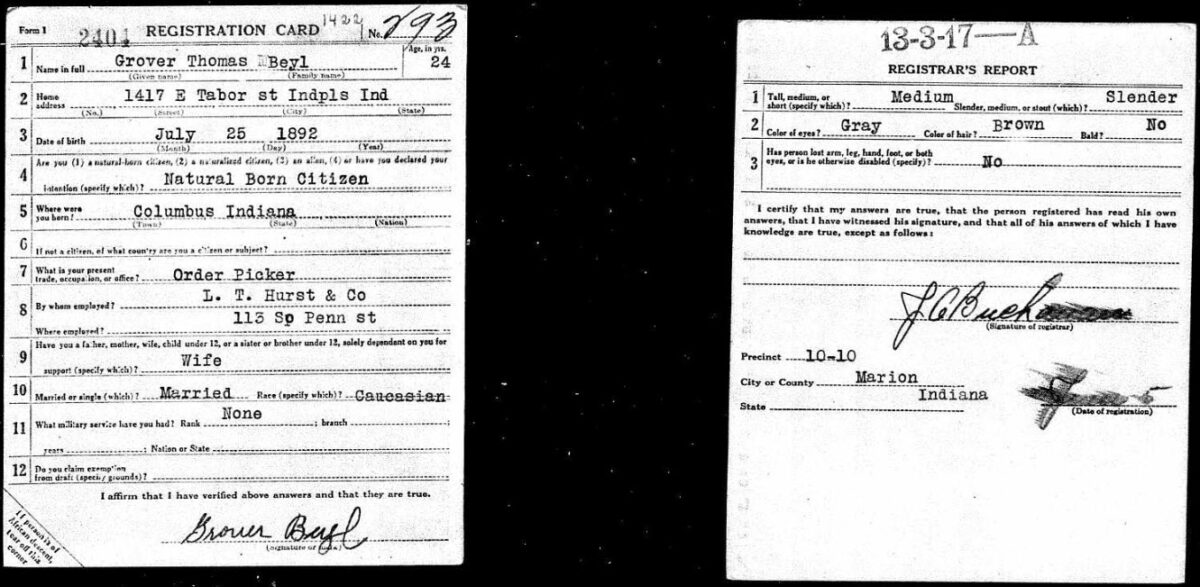
The years that followed were a whirlwind of addresses and occupations. Grover shifted from machinist to packer to laborer to clerk, eventually finding his long-term niche as a butcher. From 1917 through the 1930s, Grover’s name appeared regularly in Indianapolis city directories. He was almost always tethered to the meat trade—slicing, packing, cutting. It was honest, exhausting work.

In 1918, Grover lived at 1417 E. Tabor in Indianapolis, according to the U.S. City Directories, 1822-1995. Grover was a Clerk at the time.

In 1919, Grover lived at 1417 E. Tabor in Indianapolis, according to the U.S. City Directories, 1822-1995. Grover was a Laborer at the time.

Jacob William Jr. lived with Grover at the time. Jacob was a Carpenter.

In 1920, according to the U.S, Grover lived at 1417 E. Tabor in Indianapolis. City Directories, 1822-1995. Grover was a Laborer at the time.

According to the 1920 United States Federal Census, Grover lived at 1417 Kelly Street, Indianapolis, Indiana, with his wife, Katherine, and their daughter, Elizabeth. Katherine was 22, Grover was 27, and Elizabeth was 1 year, 8 months old. Grover’s brother, Jacob, also lived with them. He was 43 years old. And Grover’s niece, Helen Smith, lived with them at the age of 20. Grover worked as a Laborer at a Machine Shop. Jacob worked as a Laborer at a Match Shop. And Helen was a Packer at a Bakery Company.

In 1921, Grover lived at 1424 Cruft in Indianapolis, according to the U.S. City Directories, 1822-1995. Grover was a Laborer at the time.

Jacob William Jr. lived with Grover at the time. Jacob was also a Laborer.

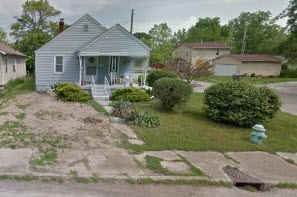
Grover was a Laborer at the time.

By the mid-1920s, Grover and Katherine had purchased a home at 1208 E. Kelly Street. In 1923, Grover lived at 1208 E Kelly in Indianapolis, according to the U.S. City Directories, 1822-1995. Grover was a Laborer at the time.

In 1924, Grover lived at 1208 E Kelly in Indianapolis, according to the U.S. City Directories, 1822-1995. Grover was a packer at the time.

In 1926, Grover lived at 1208 E Kelly in Indianapolis, according to the U.S. City Directories, 1822-1995. Grover was a meat cutter at the time.

In 1929, according to the U.S, Grover and Katherine lived at 1208 E Kelly Street in Indianapolis. City Directories, 1822-1995. Grover was a meat cutter at the time.
A newspaper article in 1929 even called them “Pioneer Residents,” praising their comfortable home and rooted presence in the community.
But behind every warm kitchen and well-worn work apron, fate waits in shadow.
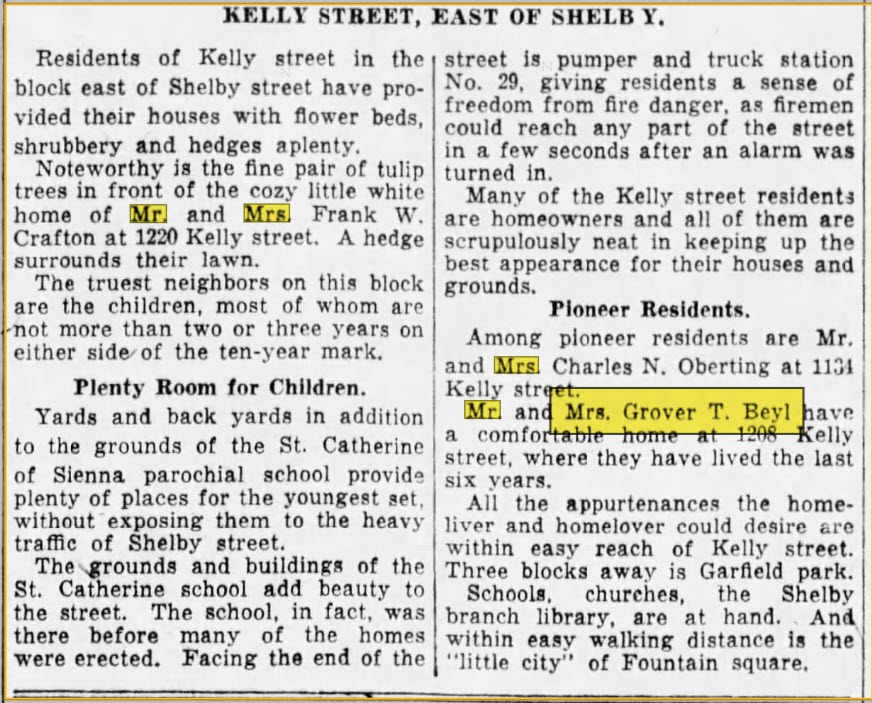
In 1930, the census recorded a household full of life: Grover, Katherine, their two daughters—Elizabeth and Helen—and Grover’s ever-present brother, Jacob. There was warmth, stability, and pride.

Grover owned the home, which was valued at $3,000. He was 37 years old at the time, and his wife, Katherine, was 32.
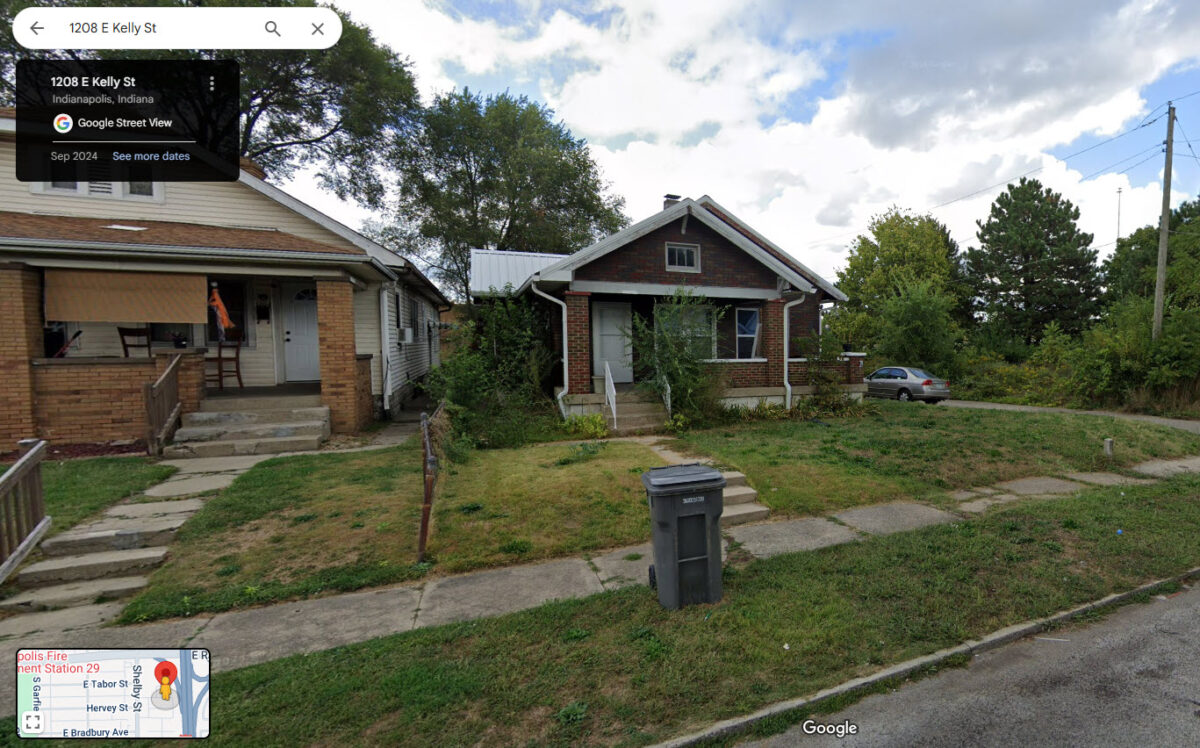
Their daughters, Elizabeth and Helen, were 11 and 9 years old, respectively, and both were in school. Grover was a Butcher at a Packing House at the time.

In 1931, Grover and Katherine lived at 1208 E. Kelly Street in Indianapolis, according to U.S. City Directories, 1822-1995. Grover was a Meat Cutter at the time.

In 1933, Grover and Katherine lived at 1208 E. Kelly Street in Indianapolis, according to the U.S. City Directories, 1822-1995. Grover was a Laborer at the time.

According to the U.S. City Directories, 1822-1995, Grover T Beyl lived at 1208 E. Kelly, Indianapolis, Indiana, with his wife Katherine M. in 1934. He was a butcher at the time. His brother and family lived nearby at 417 Parkway Avenue.

In 1935, Grover and Katherine lived at 1208 E. Kelly Street in Indianapolis, according to the U.S. City Directories, 1822-1995. Grover was a butcher at the time for Hilgemeier & Bro Inc.

In 1936, Grover and Katherine lived at 1208 E. Kelly Street in Indianapolis, according to the U.S. City Directories, 1822-1995. Grover was a butcher at the time.

In 1937, according to the U.S, Grover and Katherine lived at 1208 E. Kelly Street in Indianapolis. City Directories, 1822-1995. Grover was a butcher at the time.
A Sudden, Violent End
On August 22, 1938, Grover was involved in a devastating car accident on a local highway. The injuries were catastrophic: a concussion, a fractured clavicle, and a shattered elbow. Three days later, on August 25th at 4:50 a.m., he died at St. Francis Hospital. An autopsy confirmed what the wreck had wrought—his body broken, his story abruptly ended at the age of 47.
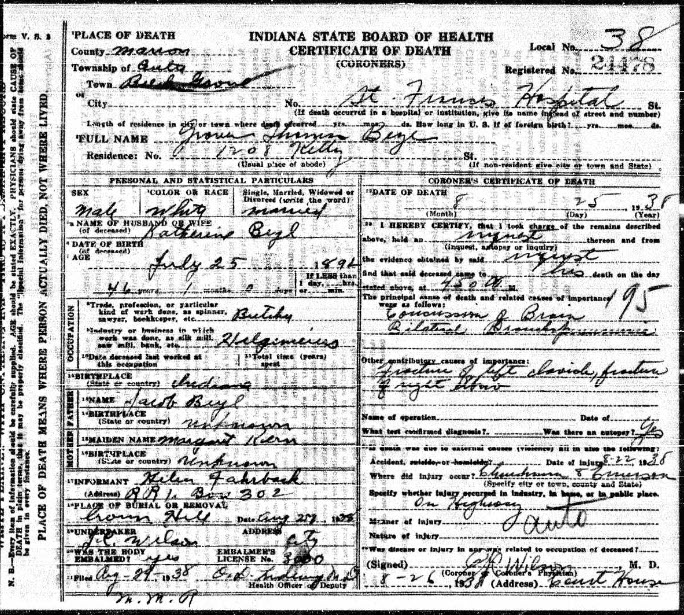
He was married to Katherine. His parents were Jacob Beyl and Margaret Kern.

His death certificate lists him as a butcher for Hilgemeier & Bro. His daughter, Helen, was the informant—a heavy burden for a young woman. Grover was laid to rest at Crown Hill Cemetery in Section 74, Lot 750. Thanks to a kind Find A Grave contributor, a photo of his headstone is now a digital memorial.

Grover Thomas Beyl lived a life of grit and motion, of labor and love. He crossed city blocks and shifting decades, raised a family, and worked with his hands until the very end. He deserves more than a footnote—he deserves a story.
And now, at least, he has one.
💬 Want to Share a Story or Memory?
Grover’s life has been carefully reconstructed here, but there’s always more to discover. If you have a memory, photo, or family story connected to Grover Thomas Beyl, we’d love to hear from you.
📝 Visit his Introduction Page to share ➤
~Kris
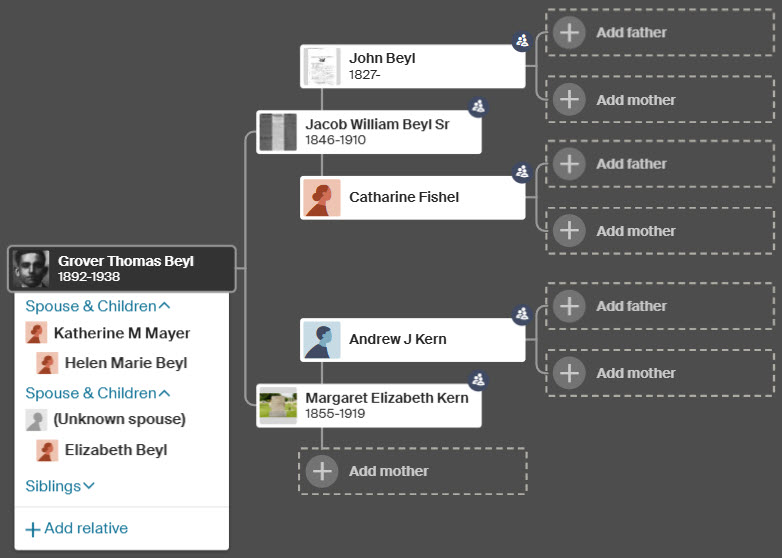
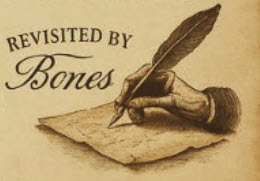
🦴 Revisited by Bones
Grover T. Beyl: Meat, Mystery & a Concussion Exit Stage Left
Ah, Grover. Butcher by trade, Beyl by blood, and the kind of guy who ping-pongs through more Indiana addresses than a door-to-door tonic salesman. You get the sense he was always moving—not just in geography, but in life. Building something. Chasing stability. Packing meat by day, playing patriarch by night, probably falling asleep in his chair before the kids could ask for a nickel.
Let’s talk about that meat-packing life for a moment, shall we? You can practically smell the sawdust and cold iron of those early 20th-century shops. It wasn’t glamorous—it was bone-wearying work (no pun intended… fine, pun fully intended). You didn’t clock out without a sore back and the scent of lard permanently clinging to your shirt. But it fed the family, and Grover did it for decades.
And then there’s the car crash.
We don’t get many endings this cinematic in the family tree. An auto accident in 1938? That was still the era of skinny tires and “brakes optional.” No seatbelts. No crumple zones. Just you, a metal box, and fate. One bad moment on the highway, and Grover’s story ends in a hospital bed with a fractured clavicle and a concussed brain. It’s brutal. It’s sudden. And if we’re being honest—it’s a little poetic. The man who survived industrial labor, city shifts, and a Great War draft card gets taken out by the 20th century’s shiny new toy: the automobile.
But what gets me most is the quiet dignity of it all.
No scandal. No splashy headlines. Just a hardworking man who kept showing up—on census forms, in city directories, in the shadows of meat lockers and narrow side streets—doing what had to be done. He bought a house. He raised daughters. He made it onto the “Pioneer Residents” list, which, frankly, is the 1930s equivalent of being called “one of the good ones.”
So here’s to Grover: the gray-eyed packer who deserved a softer landing, the man of many homes and one final headline. Your story was almost paved over like that old Bates Street lot—but not on our watch.
Sleep tight, old boy. The butcher’s ledger is closed, but your tale’s been freshly cut and served.
—Bones 🥩
🗂️ Case File: Grover Thomas Beyl – Timeline of a Working Man’s Life
A reconstructed timeline by Bones, the nosiest ancestor whisperer in town.
🍼 July 25, 1891 — Birth
According to his death certificate, Grover T. Beyl made his debut in Columbus, Indiana. (Every other record says 1892, but we’re going with the document that came last—those tend to be the most honest, if not the most accurate.)
🏡 1900 – Age 8/9
Living at 228 Jackson St., Columbus, with parents Jacob & Margaret Beyl. A crowded household, heavy with German-French ancestry and the scent of sawdust (both Jacobs worked as carpenters). Schoolboy days and front-porch summers.
🔨 1910 – Age 18/19
Still in Columbus, now at 542 Jackson St., Grover’s working as a laborer in the furniture biz—already getting those hands dirty.
⚙️ 1912 – Age 20/21
Moves to 916 Bates St., Indianapolis, with brother Edward. Listed as a machinist. (Spoiler: this neighborhood vanishes later under a sea of asphalt. Urban progress, meet historical erasure.)
🛠️ 1915 – Age 23/24
Back in Columbus at 542 Jackson St., this time working as a carpenter for Emerson-Brantingham Co. Mom’s now a widow. You can almost feel the weight of that return home.
🏠 1917 – Age 25/26
Now at 602 Woodlawn Ave., Indianapolis. Occupation: packer. It’s the year Grover registers for WWI and also the year he…
💍 March 10, 1917 — Marries Katherine Marie Mayer
Two working-class Hoosiers tying the knot. Grover lists himself as 23 (close enough) and says he was born in 1894 (okay, Grover, now you’re just guessing).
📦 1918–1920 – Age 26–28
Grover’s settled at 1417 E. Tabor St., Indianapolis. He bounces between jobs as a clerk and laborer. In the 1920 census, he’s suddenly at 1417 Kelly St., but it seems like a renumbering mix-up rather than a move. The family is growing now: Katherine and little Elizabeth, with brother Jacob and niece Helen tagging along.
🏠 1921–1922 – Age 29–31
Living at 1424 Cruft, then 1440 Cruft. More laborer gigs. The city’s growing around him, but Grover stays rooted.
🔪 1923–1926 – Age 31–35
Finds long-term footing at 1208 E. Kelly St. Occupations shift from laborer to packer to meat cutter. A butcher is born.
🏡 1929 – Age 37/38
Grover and Katherine are listed as Pioneer Residents—not just renters but homeowners with a “comfortable house” at 1208 Kelly, a symbol of stability. Their two daughters are growing up under that roof.
🥩 1930–1937 – Age 39–46
Grover sticks with the butcher trade, working for Hilgemeier & Bro Inc. He appears every year like clockwork at 1208 E. Kelly. This is his domain now. He’s no longer just surviving—he’s built something.
🚘 August 22, 1938 – Age 47
Grover is injured in an automobile accident on the highway. The details are scarce, but the injuries are not: a fractured clavicle, a broken elbow, and a brain concussion.
⚰️ August 25, 1938 – Age 47
Grover dies in St. Francis Hospital at 4:50 a.m. His daughter Helen is the informant. He’s buried two days later at Crown Hill Cemetery in Section 74, Lot 750. A stone now marks the place where his long, hardworking story rests.
Grover Thomas Beyl
(1892 - 1938)
